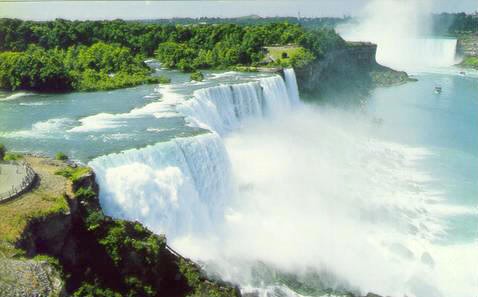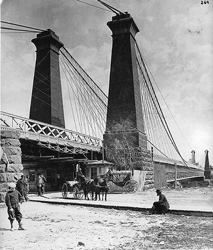Niagara Falls Geology & Geological History
The Story of the Falls began 600 million years ago. The future site of the Great Lakes stood at the centre of a broad, shallow sea that covered much of North America. Beneath these waters were the already ancient Pre-Cambrian rocks of the Canadian Shield-the bowl- shaped basement of our continent.
For 100 million years, rain and wind and the lapping of waves ground rocks into powder. This material collected, layer after layer, in the concave sea bottom, depositing soft sediments over top of the harder Pre-Cambrian rock.
Suddenly, the Earth shook, pushing forth the Appalachian mountains. Rivers flowed in new patterns, carrying mud westward. Where the rivers intermingled, huge muddy deltas formed, sprawling over 600 kilometres, from east of what is now Lake Ontario to beyond the present shore of Lake Huron. That mud, cemented by the eons, forms the distinctive purple-red shale called the Queenston Formation and the sandy ledge-forming rocks of Niagara Gorge.

The waters over the future site of the Falls were tropical, for Central North America lay much closer to the equator than it does today. In this warm sea, tiny creatures built massive honeycombed reefs that appeared as gray and white shoals in the troughs of waves. As these coral makers died, the churning of water broke up their homes, sent in a rain of lime dust to the sea floor. The Lockport Dolomite, which forms the caprock of the Niagara Escarpments, consists largely of these ground up coral reefs.
By 300 million years ago, the inland sea had drained away. Its legacy: a saucer of sediments atop the Pre-Cambrian shield nearly five kilometres deep. Fifty million years later, while the first reptiles were slowly establishing their dominion over the planet, great rivers crisscrossed central North America, etching patterns into this soft, sandy rock and undermining the harder limestones. This random erosion formed the basins for Lakes Michigan and Huron, and later, Erie and Ontario.
From the shadows of primeval forests, the first warm-blooded animals emerged: tiny shrew-like mammals and birds with teeth. Meanwhile, the reptiles grew larger and more sophisticated, becoming the dinosaur- the mightiest creatures ever to walk the land. Plants, too, were evolving. After millennia of monotonous green, the countryside exploded with colour as the first flowers appeared.
Then disaster struck. Something, perhaps an asteroid impact, wiped out the terrible lizards and all other life forms on Earth with body masses over 50 kilograms. The way was paved for our rodent ancestors to begin their slow, 60 million year climb to supremacy, until finally, half a world away, the first humans stood up and surveyed the beauty around them.
All the while, though, Canada had been slowly moving farther north, a raft of basalt and granite floating upon a magma sea. This continental drift put us right in the path of a devastating natural force that would completely change the landscape.
It happened four times in rapid succession, each time moulding North America the way a sculptor might re-shape a lump of clay. During the last Ice Age- the Wisconsin Glaciation-the north polar cap expanded greatly, covering most of Canada in a vast sheet of ice a kilometre and a half thick.
Centimetre by centimetre, year by year, the ice sheet grew pushing ahead of it those things that would move, mercilessly crushing those that would not. Eventually the face of the glacier, taller than the tallest skyscraper, extended east and west from where tourists view Niagara Falls today.
Twelve thousand years ago, the ice drew back far enough to expose a low channel to the Hudson Valley, located near the present site of Rome, New York. The waters in the western end of the Ontario basin began to drain through this new outlet.
Year after year, the water level sank until the Niagara Escarpment was exposed. Lake Erie spilled over the top of the Escarpment to a lower level, a basin called Lake Iroquois that was the forerunner of Lake Ontario. At first, the Erie waters drained to the lower lake by way of a small intermediate lake called Tonawanda, which, in turn, drained over the escarpment through several spillways. But gradually the drainage from Erie to Iroquois concentrated into one channel, the ancestor of the Niagara River.

Lake Iroquois was roughly the same shape as the Lake Ontario it was to become, but its water level was higher and its basin larger. Ice that still lay near the Thousand Islands blocked it from the St. Lawrence Valley. Niagara-on-the-Lake was submerged and the Iroquois waters lapped at the top of Queenston Heights.
Finally, the ice sheet stopped growing, bested by a slight increase in the average yearly temperature. The leading edge of the glacier began to melt, forming a giant muddy mess shot through with the boulders it had picked up during its journey. At last, the ice pulled away from The Thousand Islands. In a spectacular rush, the waters of Lake Iroquois began to surge through this newly opened channel and eventually drained into the Atlantic.
The glacier waned, but the melt water-hundreds of cubic of it-had to go somewhere. Much of it flowed off the sides of the continent into the oceans. Some of it evaporated. The rest pooled into the hollows and ruts scraped into the land by the glacier, including the vastly enlarged basins of the Great Lakes. The Earth's crust, relieved of the tremendous weight of the ice, began to spring back, but it did so unevenly, tipping to the south. That changed the drainage patterns, starting the flow of water through the Niagara River. Great animals followed the retreating glacier northward. Some of these species would survive to the present. Others, such as the dire wolf and the mastodon, wouldn't be able to keep up with the changing climate. And others still, such as the cervalces, a deer with antlers three metres wide, would succumb to the spears of the first humans to walk the land, almost 12,000 years ago. A new era had begun.



